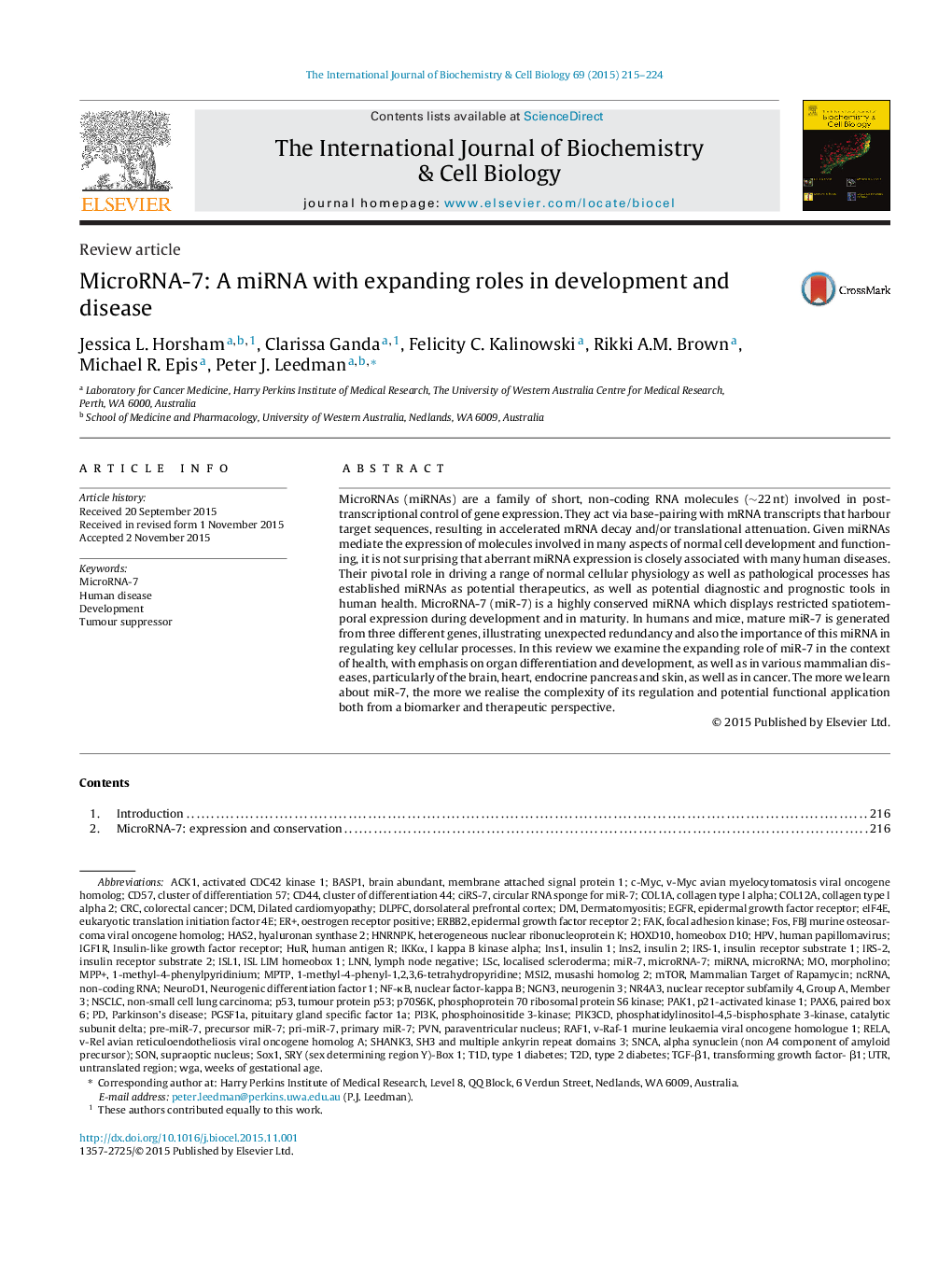| Article ID | Journal | Published Year | Pages | File Type |
|---|---|---|---|---|
| 8322441 | The International Journal of Biochemistry & Cell Biology | 2015 | 10 Pages |
Abstract
MicroRNAs (miRNAs) are a family of short, non-coding RNA molecules (â¼22Â nt) involved in post-transcriptional control of gene expression. They act via base-pairing with mRNA transcripts that harbour target sequences, resulting in accelerated mRNA decay and/or translational attenuation. Given miRNAs mediate the expression of molecules involved in many aspects of normal cell development and functioning, it is not surprising that aberrant miRNA expression is closely associated with many human diseases. Their pivotal role in driving a range of normal cellular physiology as well as pathological processes has established miRNAs as potential therapeutics, as well as potential diagnostic and prognostic tools in human health. MicroRNA-7 (miR-7) is a highly conserved miRNA which displays restricted spatiotemporal expression during development and in maturity. In humans and mice, mature miR-7 is generated from three different genes, illustrating unexpected redundancy and also the importance of this miRNA in regulating key cellular processes. In this review we examine the expanding role of miR-7 in the context of health, with emphasis on organ differentiation and development, as well as in various mammalian diseases, particularly of the brain, heart, endocrine pancreas and skin, as well as in cancer. The more we learn about miR-7, the more we realise the complexity of its regulation and potential functional application both from a biomarker and therapeutic perspective.
Keywords
EGFRNF-κBPI3KFOSLSCTGF-β1p53ERBB2DCMmTORFAKCD44p70S6KMPTPDLPFCPax61-methyl-4-phenylpyridiniumT2DIGF1RSNCAIRS-1Msi2PAK1eIF4EWGAT1DNR4A3ncRNANeuroD1CD57IKKαv-myc avian myelocytomatosis viral oncogene homologHAS2Tumour protein p53SOX1PIK3CDcollagen type I alpha 2hnRNPKmicroRNA-7human antigen RIRS-2HOXD10BASP1Ngn3ACK1Heterogeneous nuclear ribonucleoprotein KFBJ murine osteosarcoma viral oncogene homologcol1av-rel avian reticuloendotheliosis viral oncogene homolog AISL LIM homeobox 1Ins2Ins11-methyl-4-phenyl-1,2,3,6-tetrahydropyridineeukaryotic translation initiation factor 4Ec-MycER+isl1MiR-7MPP+p21-activated kinase 1Non-coding RNAinsulin 1insulin 2Insulin receptor substrate 2Human diseaseParkinson's diseasePaired box 6cluster of differentiation 44dermatomyositisType 2 diabetesType 1 diabetesRelADevelopmentRaf1insulin receptor substrate 1Colorectal cancerNSCLCTumour suppressorShank3Nuclear factor-kappa BSONphosphoinositide 3-kinasedorsolateral prefrontal cortexPVNUTR یا untranslated regions untranslated regionmorpholinoMicroRNAMiRNANeurogenin 3mammalian target of rapamycinSupraoptic nucleusparaventricular nucleushyaluronan synthase 2Human papillomavirusHPVHuRDilated cardiomyopathynon-small cell lung carcinomaCRCfocal adhesion kinaseEpidermal growth factor receptor 2Epidermal growth factor receptorInsulin-like growth factor receptor
Related Topics
Life Sciences
Biochemistry, Genetics and Molecular Biology
Biochemistry
Authors
Jessica L. Horsham, Clarissa Ganda, Felicity C. Kalinowski, Rikki A.M. Brown, Michael R. Epis, Peter J. Leedman,
